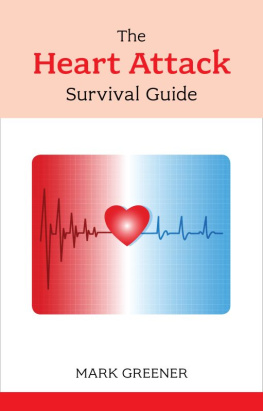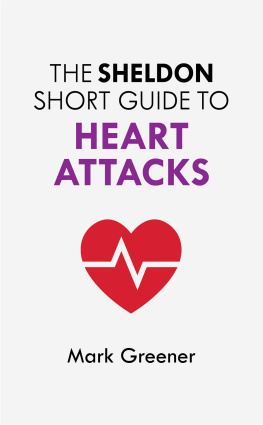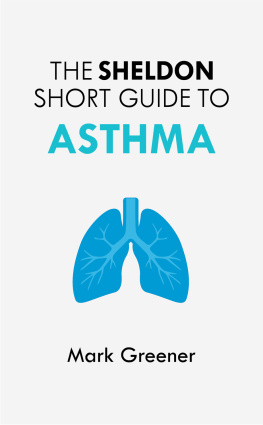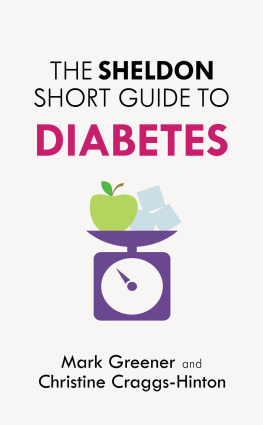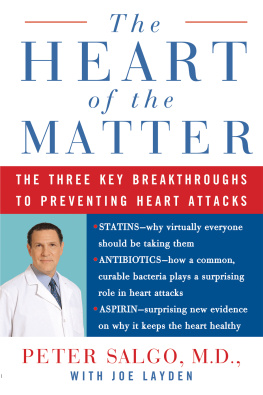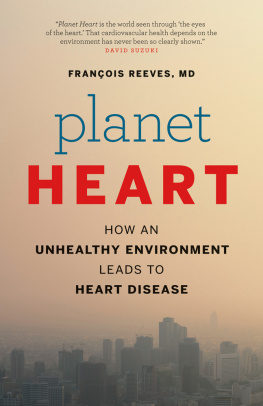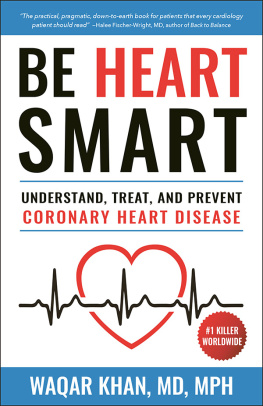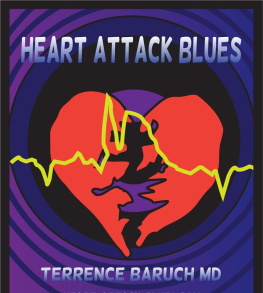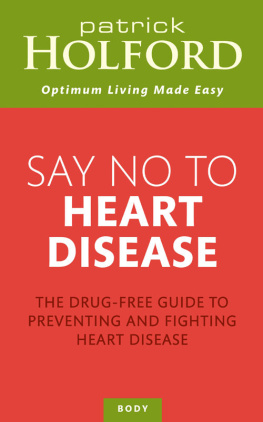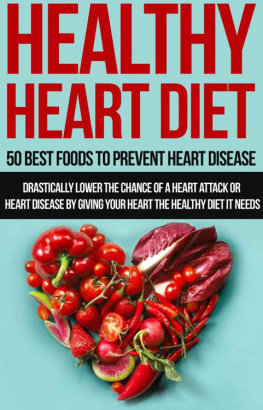The Heart Attack Survival Guide
Mark Greener spent a decade in biomedical research before joining MIMS Magazine for GPs in 1989. Since then, hes written on health and biology for magazines worldwide for non-specialists, healthcare professionals and scientists. Hes the author of 11 other books, including Coping with Asthma in Adults (Sheldon Press, 2011). Mark lives with his wife, three children and two cats in a Cambridgeshire village.
Overcoming Common Problems
The Heart Attack
Survival Guide
MARK GREENER

First published in Great Britain in 2012 by Sheldon Press
An Hachette UK Company
Sheldon Press
Carmelite House
50 Victoria Embankment
London EC4Y 0DZ
www.sheldonpress.co.uk
Copyright Mark Greener 2011
All rights reserved. No part of this book may be reproduced or transmitted in any form or by any means, electronic or mechanical, including photocopying, recording, or by any information storage and retrieval system, without permission in writing from the publisher.
The author and publisher have made every effort to ensure that the external website and email addresses included in this book are correct and up to date at the time of going to press. The author and publisher are not responsible for the content, quality or continuing accessibility of the sites.
British Library Cataloguing-in-Publication Data
A catalogue record for this book is available from the British Library
ISBN 978-1-84709-203-8
To Rose, Yasmin, Rory and
Ophelia with love
Every four minutes someone in the UK suffers a heart attack, according to the British Heart Foundation (BHF). So, each year, the National Health Service (NHS) manages around 124,000 heart attacks most of which strike without warning. In 60 to 70 per cent of cases, the first sign of coronary heart disease (CHD) the condition underlying most heart attacks is sudden death or a myocardial infarction (MI), the medical term for a heart attack, as Gutterman noted in Circulation Journal.
Heart attacks kill, the BHF estimates, about 88,000 people a year around one person every six minutes. In fact, CHD is the UKs leading cause of death, killing more people than lung, colorectal, breast and prostate cancer combined. (CHD includes angina and heart attacks, but not stroke or heart failure.) Worryingly, many people who suffer a heart attack die despite receiving advanced medical care. Between 11 and 12 per cent of men and 15 to 19 per cent of women die during the 30 days after theyre admitted to hospital with a heart attack. Many other heart attack victims die before they even reach hospital.
Despite these sobering statistics, a heart attack isnt a death sentence. Improved treatments and greater awareness of risk factors among the public and health-care professionals have driven down deaths from heart disease over recent decades. Today, around 1 million men and almost 500,000 women are still alive after suffering heart attacks, the BHF estimates.
Yet, as thousands of funerals each year underscore, theres no room for complacency. Millions of people across the UK are at risk of suffering their first heart attack. And if you survive one heart attack, you may well face another. An MI is a symptom of CHD and not the disease itself. So, a fifth of people who survive a heart attack suffer another MI in the next seven years, according to Haffner and colleagues. If youre one of the 2.8 million people with diagnosed diabetes in the UK (or one of the 850,000 who are unaware they have diabetes), your risk of having another heart attack after your first MI rises to almost 50 per cent the chance of successfully calling heads when you flip a coin.
Everyones at risk
Often CHD seems to be a disease of civilization. After all, were more likely than our distant ancestors to stuff our faces with energy-dense, high-fat processed food, while puffing on cigarettes and rarely moving our overweight bodies from the sofa. Diet, obesity, smoking and inactivity are important modifiable risk factors for heart attacks. But atherosclerosis the fatty deposits clogging up our blood vessels that cause most angina attacks and MIs has lurked in our circulation for millennia.
In 1852, Johann Nepomuk Czermak, an AustrianGerman scientist, found atherosclerosis in two ancient Egyptian mummies: a teenage boy and an elderly woman. More recently, Allam and colleagues found definite atherosclerosis in 12 of 44 ancient Egyptian mummies. Another eight mummies showed changes that probably indicated atherosclerosis. Two showed atherosclerosis in the blood vessels supplying the heart (the pattern responsible for heart attacks), including a princess who lived around 1580 to 1550 bc.
Indeed, atherosclerosis is present from the cradle to the grave. Foetuses may show fatty streaks smeared along the inside of their blood vessels. Doctors found atherosclerosis when they autopsied young, relatively fit men tragically killed during the Korean War. However, CHD typically takes decades to mature and symptoms usually emerge in middle age and beyond. So, as this book shows, theres plenty of time to tackle heart disease even if youve already developed angina, suffered a heart attack or are in your autumn years.
Breaking your heart
While almost anyone could suffer a heart attack, certain people are especially vulnerable. For example, cardiovascular disease kills just over half of people with type 2 diabetes. Stress, depression and other psychosocial factors contribute to around a third of heart attacks. And everyones exposed to traffic pollution, the most common heart attack trigger.
These risk factors cluster. Hypertension (dangerously raised blood pressure), an important and common risk factor for MI, is between five and six times more common in obese people than in those of healthy weight. Around 4060 per cent of people with type 2 diabetes have hypertension. But raised blood pressure increases MI risk whether youre chubby or lean and whether or not you have diabetes.
The more risk factors you have, the greater your chances of suffering a heart attack. According to INTERHEART a major, worldwide investigation into MI risk factors people with diabetes who smoke and have hypertension are 13 times more likely to suffer a heart attack than those without any of the three risk factors. Add a harmful profile of fat in your blood and obesity to these three risk factors and youre almost 69 times more likely to have a heart attack. People unfortunate enough to suffer psychosocial problems (such as severe stress at home or work, or depression) in addition to the five other risk factors are a massive 334 times more likely to suffer a heart attack than those without any of these risk factors.
This Heart Attack Survival Guide shows how you can reduce your blood pressure and cholesterol levels, quit smoking, lose weight and tackle stress although you may need a helping hand from your doctor. The changes suggested in this book will dramatically improve your hearts health, help prevent your first MI and boost your chance of living a full life even if youve already suffered a heart attack or unstable angina which is a dangerous first cousin to MI. Remember that heart attacks are symptoms of an underlying disease. So, surviving long term means tackling the message atherosclerosis and not just the messenger (angina or MI).
Unfortunately, you cant do much about two other influential risk factors: age and sex. In England, around one man in every 167 and one woman in every 1,000 aged 3544 years have experienced an MI, the BHF reports. The proportion rises to about one in six men and one in 11 women aged at least 75 years. Nevertheless, modifiable and unmodifiable factors interact to determine your overall risk. So tackling hypertension, stress, smoking and so on can reduce your chance of suffering a heart attack, whether youre young or old, male or female.

